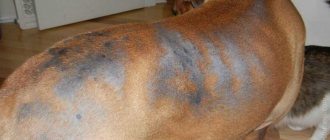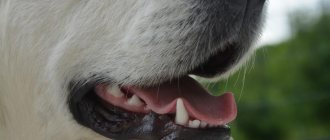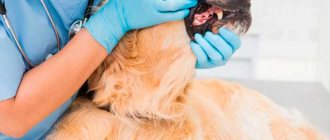Diagnosis and treatment of dirophyllariasis
Dirofilariasis is a parasitic zooanthroponotic disease caused by roundworms (nematodes) of the genus Dirofilaria, which is translated from Latin as “evil thread”. Adult nematodes are thin filaments that can reach more than 38 centimeters in length and up to 1.3 millimeters in diameter. This disease mainly affects dogs and members of the canine family, but animals from the family of cats, mustelids, hamsters, eared seals, raccoons, bears, porcupines, as well as humans are also susceptible to infection. Infection occurs through the bites of mosquitoes infected with microfilariae during the period of their activity from spring to autumn.
Why should you be wary of dirofilariasis?
The danger of dirofilariasis is that sexually mature individuals of dirofilaria cause damage to the lung tissue, myocardium, can cause blockage of the renal tubules by microfilariae, and with very strong invasion they can also affect other organs. A large role in this is played by the long absence of symptoms and their nonspecificity, which complicates diagnosis.
In Belarus, Russia and Ukraine, there are mainly 2 types of dirofilaria: Dirofilaria immitis - parasitizing in the pulmonary vessels and right parts of the heart, and Dirofilaria repens , which parasitize in the subcutaneous tissue and muscle tissue.
Treatment of dirofilariasis
Treatment of dirofilariasis in dogs is a very long, extremely difficult and quite expensive task. Unfortunately, in practice, it is not always possible to cure the disease. When approaching the treatment of dirofilariasis, several stages can be distinguished:
- Destruction of sexually mature pathogens, which, depending on the form of the disease, accumulate in the heart, lungs, subcutaneous fatty tissue and pulmonary vessels;
- Destruction of the offspring of pathogens circulating through the circulatory system
- The use of intravenous infusions to reduce signs of poisoning by drugs and parasite waste products
- Reducing side effects and maintaining internal organs - Renal Advanced, Legafiton, Hepatovet, etc.
For all these purposes, drugs are used - Levamisole, Fuadin, Arsenamide, Filarsen, Diethylcarbamazine.
How does infection occur?
As mentioned earlier, infection occurs through mosquitoes infected with microfilariae during the spring-summer-autumn periods, when they are most active. Like all parasitic diseases, they have their own development cycle:
Sexually mature female dirofilariae secrete many first-stage larvae (microfilariae), which are carried through the bloodstream throughout the dog’s body. The mosquito feeds on the blood of an infected animal, ingesting microfilariae, which develop in the mosquito's body over the course of two weeks, going through the second and third stages. The third stage of development of the parasite is invasive, i.e. capable of infection. When mosquito bites, infective larvae, entering the subcutaneous tissue, go through the fourth and fifth stages
(in simple terms, they “shed”). Next, the cycles of the two types are separated: D. repens remain in the subcutaneous tissue, forming nodules, thereby causing the cutaneous form of the disease, and D. immitis migrates into the systemic circulation and spreads to the pulmonary arteries and/or the heart, where they subsequently reach sexual maturity. From the moment of infection by an infected mosquito until microfilariae appear in the blood, 6-8 months pass. And the cycle repeats with the next mosquito bites. The lifespan of helminths can reach 7-8 years. In severe cases, dirofilaria infestations can close the lumen of blood vessels, the right side of the heart, cause thromboembolism, microfilariae can clog kidney tubules, and migration of larvae to other organs is also possible. Microfilariae can cross the placenta and infect puppies in the womb. A person can become an accidental host of these parasites. It is a dead end in the development cycle of heartworms; they do not reach sexual maturity in the human body.
Diagnosis and differential diagnosis of dirofilariasis in cats
It is important to note that general laboratory blood tests are not used to diagnose this lesion due to their low information content. In cats, dirofilariasis is more difficult to diagnose than the same disease in canines.
- If dirofilariasis is in cats, then for diagnosis in furry pets the following is used:
- Checking for the presence of microfilariae in the bloodstream. To do this, a sample is taken using a hematocrit tube.
- Test for the presence of antibodies. Although in most cases this study is negative even if the presence of parasites in the body is proven, however, in combination with other research methods, antibody analysis gives good results.
- Serology. But this analysis gives an answer only if there are female helminths 7-8 months old or recently died. But in cats, a third of diseases are caused by male heartworms. And a negative indicator in this type of study does not guarantee the absence of parasites.
- X-ray examination is indicative of the fact that an expanded pattern of the bronchial tree is detected when parasites are in the bronchi, as well as noticeable lesions of the pulmonary vessels in the caudal (posterior) pulmonary lobes.
- Research using echocardiography can help, since helminths are detected as linear structures in the form of the well-known mathematical equal sign.
Differential diagnosis involves distinguishing between the symptoms of dirofilariasis in cats and other diseases of the respiratory and cardiovascular systems. It is necessary to differentiate this immediately from dermatitis, demodectic lesions, from staphylococcal infections, bronchopneumonia and various pleurisy with different etiologies.
Treatment of the underlying disease if dirofilariasis has developed in cats
Melasormin is recommended as a primary treatment with significant effectiveness .
Carefully! The drug is poisonous due to the presence of arsenic compounds in the drug. Treatment with Melasormin should only be carried out by a veterinarian in a hospital setting.
It is indicated that the positive effect of therapy was obtained with the use of drugs such as Ivermectin and Pyrantel . These drugs have shown excellent results even in late stages of the disease.
It is highly recommended to use these drugs even in healthy animals to prevent the occurrence of the disease. In this case, even when bitten by heavily infected mosquitoes, the cat remains protected from invasion. These drugs also have a certain degree of toxicity and it is thanks to this that they affect the parasite larvae. But these medications cannot cure a sick animal in the later stages.
Treatment of damaged organs may include the use of glucocorticoids and drugs to restore normal functioning. Maintenance therapy is prescribed for the same purpose.
During illness, an animal loses a lot of strength to fight the parasites themselves and poisons.
, which enter the blood during the life of worms.
For breathing problems, for example, drugs that dilate the lumen of the bronchi are prescribed. And in case of cardiac dysfunction, cardiotonics are indicated .
To support the cat
He is prescribed vitamin injections. The use of desensitizing drugs is indicated to reduce the immediate type of reaction, which is expressed in allergies and/or even in anaphylaxis.
It is especially worth noting that the cat’s nutrition during the period of illness and recovery after treatment should be of high quality, fresh products. The content of proteins and other nutrients should be increased, taking into account their deficiency in the body of a sick animal. To facilitate digestion of food, it should be crushed and at a comfortable temperature. And when using ready-made diets, you should select them in accordance with the current condition of the cat.
What symptoms may this disease have?
Dirofilariasis comes in two forms: cutaneous and cardiopulmonary. The cutaneous form is asymptomatic in most animals. Basically, nodular lesions in the muzzle area, itchy papules as with sarcoptic mange and other nonspecific signs are often noticed: dermatitis, alopecia, abrasions, scratches. But the cardiopulmonary form has greater veterinary significance. Symptoms can be different and very often they are nonspecific: at first, asymptomatic carriage is likely, with the development of helminth, weakness, weight loss, and fever may be observed. As the course progresses, there is a disruption in the functioning of the cardiovascular system: fatigue, dry cough, including with blood; shortness of breath, especially noticeable during exercise; loss of consciousness due to lack of oxygen and blood supply; the appearance of fluid in the chest and abdominal cavity. Further, syndromes of heart and pulmonary failure, vena cava syndrome, and glomerulonephritis appear. It is possible for parasites to migrate to non-specific places: liver, brain and spinal cord, eyes, kidneys, etc.
How do you know if an animal has heartworm disease?
Diagnosis is carried out comprehensively: starting with collecting anamnesis, examination, clarifying any symptoms, taking blood for biochemical and general analysis - i.e. usual routine manipulations at appointments, but the most important contribution to the diagnosis comes from the laboratory, cardiac ultrasound and x-ray.
Suspicion may already be caused by the result of a general blood test, the form of which may show signs of anemia and a decrease in the number of platelets, as with babesiosis; On the leukocyte formula of this form, neutrophilia and pronounced eosinophilia are possible. Next, a blood smear is made for microscopy and microfilariae are detected (or not); The Knott test is done for the same purpose. Enzyme-linked immunosorbent and immunochromatographic tests are carried out to detect the D.immitis antigen - a negative result for the antigen in the presence of microfilariae in the blood may indicate that the animal has a cutaneous form of the disease. Antigen tests are repeated after 6-7 months. The most accurate method of research with species differentiation is the polymerase chain reaction (PCR), it allows you to detect the DNA of D.immitis and D.repens. Ultrasound of the heart (echocardiography) and x-rays are special research methods. On ultrasound it is possible to see the enlargement of the right side of the heart and adult specific D.immitis. On an x-ray you can see the expansion of the pulmonary artery and its branches, infiltrates and enlargement of the heart. Echocardiography and X-ray examination make it possible to differentiate the cardiopulmonary form of the disease from the cutaneous form. Diagnosis of the skin form of the disease, in addition to the above studies, also includes an external examination of the animal’s body: searching for nodules, alopecia, papules, and inflammation.
Prognosis and prevention
To prevent this from happening to your pet, you need to take preventive measures seriously. In this regard, you should try to ensure that the dog does not come into contact with mosquitoes, which are the main carriers of the parasites in question. It is necessary to ensure that she is not in places where they accumulate, and for prevention, her fur should be constantly treated with protective agents against these insects, as well as ticks, fleas, lice eaters, etc.
Some owners, before going out with their dog for a walk, always treat its fur with mosquito repellent spray, which they themselves use. And they do the right thing. Who knows what could happen during a walk or trip with a pet into nature.
It also doesn’t hurt to constantly use drugs like “Advocate”, which allow you to destroy nematodes even in the microfilariae stage. Another remedy for dirofilaria called “IN-AP complex” has appeared on the market. It should be applied to the animal’s skin at the beginning of summer, and then the treatment should be repeated every 6-7 weeks. The product is well absorbed into the blood and, once there, destroys the larvae of heartworms.
It is possible that many who have encountered this pathology in a pet ask themselves questions: is it possible to completely cure dirofilariasis, is there any point in spending money on such an expensive treatment and suffering yourself, as well as torturing the animal? Such doubts are well founded.
The prognosis for this disease is always positive if you seek veterinary help in a timely manner and make a correct diagnosis. In this case, there is no need to spare money and effort to get your pet back on its feet. After all, this animal is often a full member of the family for many. And his return to normal life will be a gift not only for him, but also for his owner, to whom he will reciprocate for his care with even greater love and devotion. Always be attentive to your four-legged friend, and then he will not be afraid of any illnesses, including dirofilariasis.
Currently reading:
- Thyroid dysfunction in dogs (hypothyroidism)
- Types of worms that can infect dogs
- What to do if your dog has heart failure
- Seven Signs and Remedies for Getting Rid of Fleas in Dogs
Is it possible to avoid heartworm infection?
The danger of dirofilariasis for a dog’s health makes the issue of preventing this disease particularly relevant.
Unfortunately, 100% effective means of protection have not been developed to date. The main focus in the prevention of this disease is to protect the dog from mosquitoes and other blood-sucking insects that carry the larval stage of helminths.
Prevention is based on protecting the dog from mosquito bites using special means: for this, various collars, sprays, ivermectin preparations (Novomek, Otodectin), selamectin (Stronghold), moxidectin (Advocate, Inspector) and etc. according to the manufacturer’s instructions during the period of mosquito activity.
Dogs are highly susceptible to heartworm infection (they get infected very, very easily) and are not that easy to protect. On the one hand, there is nothing complicated in prevention, on the other hand, there are a number of important details that the doctor should know about, and which the animal owner must observe. If prevention is carried out incorrectly, animals will become infected.
Medicines for prophylaxis should be prescribed by a veterinarian, with therapeutic cooperation from the animal owner.
Don't neglect prevention!
Dirofilariasis is a dangerous and difficult to treat disease.
Can a person get sick?
Because a dog or cat is the definitive host; the likelihood of a person becoming infected with heartworms from a sick animal is minimal. But mosquitoes, being intermediate hosts, can lead to infection of humans with worms.
People more often become ill with helminths that affect the skin, eyeballs and eyelids of a person.
To avoid possible infection, you need to use repellents in the warm season, treat not only clothing, but also especially exposed areas of the body.










